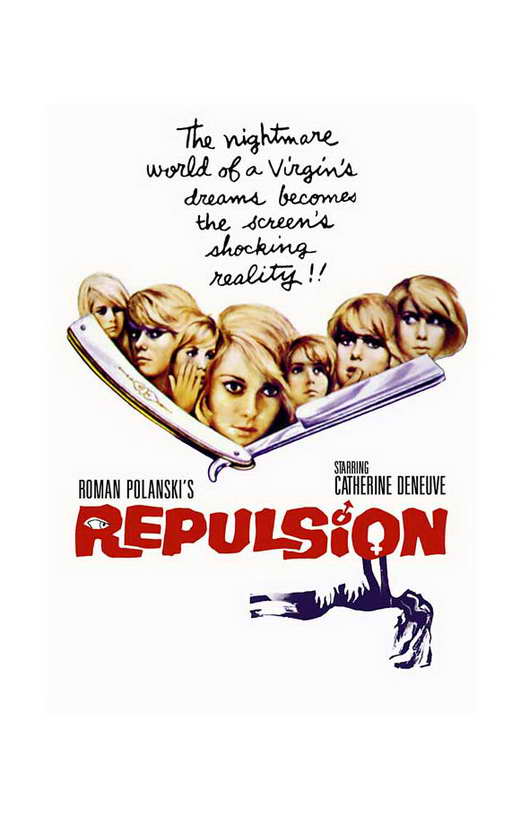
Fig 1. Repulsion Cover
Repulsion is a horror film that stands out as it stands among the few to use female killers. The majority of the story takes place in an apartment which Carol shares with her older sister. Carol is shown very early on as being a shy type who is only really comfortable around women. The older sister and her partner go away on holiday, leaving her alone in the apartment. The film then shows loops of her going to her job and returning back to the apartment. Gradually hallucinations begin to take hold of her. The isolation in the apartment is filled with visions of cracks in the walls, hands that reach out from the sides of the corridor and shocking silent nightmare sequences that sees an unknown intruder return each night to molest her. These scenes in particular are disturbing for a number of reasons, they are silent apart from the escalated noise of a ticking clock and the lack of sound forces the viewer to watch to make sense of what is happening.
Peter Bradshaw from www.theguardian.com had this to say in his review ''There can't be many other films which so plausibly show an entire, warped world created from a single point of view.'' (Bradshaw, 2013). The fact that the film uses only the distorted view of Carol throughout the film only makes it stronger in terms of its themes. Being a film that focuses on a characters quickly degrading mental health, it seems only right that the viewer is only allowed scenes from her viewpoint. Repulsion uses cracks in the apartment walls and hallucinations to bring the message across that all is not well with the character they are seeing. The cracks become ever more prominent as the film progresses and this is clearly a sign for the viewer that things are getting worse.

Fig 2. Wall Crack.
Bosley Crowther talks about the sound-scape of the film in his review ''And with sound, too, Mr. Polanski weaves a fabric of tremendous effects.'' (Crowther, 1965). The sound in the film or lack thereof is definitely a key that makes the bizarre scenes and images in the film all the more engaging to the audience. The eerie clock ticking that takes over the otherwise soundless nightmare scenes, the roaring ripping sound that accompany the tearing walls and the quiet apartment scenes that flow into busy street scenes. The last in particular shows how perhaps the outside world is portrayed to show her dwindling sense of sanity and the inside is portrayed as a projection of her ever deepening madness.
In their review of the film, Kim Newman states ''Hitchcock ends the film with a lecture on why Norman is mad, but Polanski just closes in on a family photograph to drop hints about the roots of the blonde angel’s insanity.'' (Newman, s.d.). While Polanski can be easily compared to Hitchcock for their similar uses of the mental state of characters in their films, this quote brings up their distinct differences. While Hitchcock may like to be clear with audiences about what they are seeing, Polanski seems to use subtle tricks and techniques to more organically steer the viewer into understanding scenes. Polanski uses numerous metaphors for Carol's mental well-being, the cracks and the slowly rotting rabbit to name only two(See Fig 3).

Fig 3. Rotting Rabbit
The clever subtlety in this film and the excellent uses of sound are without a doubt two defining factors that have seen this film rise above others in the horror genre.
Illustration List
Polanski, R (1965) Figure 1. Repulsion Cover. http://images.moviepostershop.com/repulsion-movie-poster-1965-1020434006.jpg (Accessed on 27/11/14)
Polanski, R (1965) Figure 2. Wall Crack. https://blogger.googleusercontent.com/img/b/R29vZ2xl/AVvXsEiIIdlxAHqle7hWxJubWTdcy_UbAPC7QxzmFtDBasf-UMtIPjZIsPfv2Sey31yEOa-dbnvTMUSur0ZGsxZPV7r8GzunMK3QbRfkgTQSK-itetel9GsaKNrSC0U9ZDP2Bnc1Bn5duRdnFzM/s1600/repulsion+3.jpg (Accessed on 28/11/14)
Polanski, R (1965) Figure 3. Rotting Rabbit. https://unholyterrors.files.wordpress.com/2012/03/repulsion18.png (Accessed on 28/11/14)
Bibliography
Bradshaw, P (2013) http://www.theguardian.com/film/2013/jan/03/repulsion-review (Accessed on 28/11/14)
Crowther, B (1965) http://www.nytimes.com/movie/review?res=EE05E7DF1739E471BC4C53DFB667838E679EDE (Accessed on 28/11/14)
Newman, K (s.d.) http://www.empireonline.com/reviews/reviewcomplete.asp?FID=134914 (Accessed on 28/11/14)

Nice one Jack :)
ReplyDeleteI think you maybe needed to introduce the film 'Psycho' before launching into the quote comparing Hitchcock and Polanski... at the moment, your reader could be left a bit confused as to who 'Norman' is.